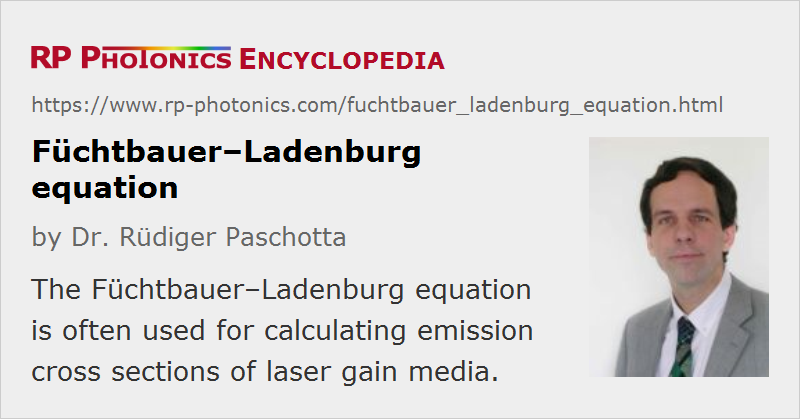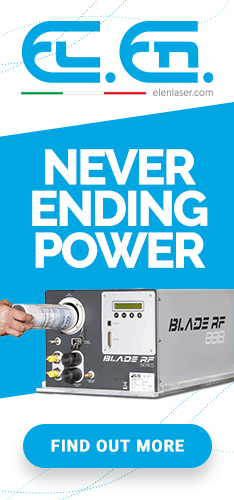Füchtbauer–Ladenburg Equation
Definition: an equation used for calculating emission cross sections of laser gain media
German: Füchtbauer-Ladenburg-Gleichung
Category: physical foundations
How to cite the article; suggest additional literature
Author: Dr. Rüdiger Paschotta
The Füchtbauer–Ladenburg equation (often called Fuchtbauer–Ladenburg equation) is part of a procedure for determining emission cross sections of laser gain medium. The procedure is based on the analysis of fluorescence related to an electronic transition of a medium. The wavelength-dependent fluorescence intensity is essentially proportional to the emission cross section times the fifth power of the optical frequency. For a not too large emission bandwidth, the latter factor may be regarded as constant, so that the fluorescence intensity is regarded as simply proportional to the emission cross sections. It is further assumed that the spectral shape of the recorded fluorescent light is not modified e.g. by wavelength-selective absorption and amplification processes in the medium.
While the spectral shape of fluorescence light is relatively easily measured, it is much more challenging to measure absolute values, because various factors such as the doping concentration, degree of electronic excitation, collection efficiency and detection efficiency would have to be known. Therefore, the absolute scaling of the obtained cross-section spectrum is often obtained in some other way. According to the Füchtbauer–Ladenburg method, one exploits the fact that the quantum efficiency of a laser transition is often near unity. This means that the upper-state lifetime is close to the radiative lifetime, which itself is determined by the emission cross sections for transitions to any lower-lying energy levels. This is quantitatively described by the equation
for the inverse radiative lifetime, where ν is the optical frequency, n is the refractive index, c is the vacuum velocity of light, and σem(ν) denotes the frequency-dependent emission cross sections. The equation can be considered as an extension of the relation between the Einstein A and B coefficients. With the above-mentioned approximation for a narrow emission bandwidth, this leads to
where the dominator contains the mean wavelength of the considered transition. Using the fact that the fluorescence intensity I(λ) is proportional to the emission cross section (within a narrow frequency interval), this leads to the Füchtbauer–Ladenburg equation

If the intensity is normalized to be 1 at the peak of the optical spectrum, the integral in the denominator can be interpreted as the effective emission bandwidth (which can be verified easily for a spectrum with rectangular shape).
One should keep in mind the approximations used for the Füchtbauer–Ladenburg equation. In particular, it is important to consider all lines of a fluorescence spectrum. If these are spread over a substantial spectral range, the approximation of a narrow bandwidth is not fulfilled (even if the single lines are narrow). It is not difficult, though, to generalize the equation for that situation.
Questions and Comments from Users
Here you can submit questions and comments. As far as they get accepted by the author, they will appear above this paragraph together with the author’s answer. The author will decide on acceptance based on certain criteria. Essentially, the issue must be of sufficiently broad interest.
Please do not enter personal data here; we would otherwise delete it soon. (See also our privacy declaration.) If you wish to receive personal feedback or consultancy from the author, please contact him e.g. via e-mail.
By submitting the information, you give your consent to the potential publication of your inputs on our website according to our rules. (If you later retract your consent, we will delete those inputs.) As your inputs are first reviewed by the author, they may be published with some delay.
Bibliography
| [1] | W. B. Fowler and D. L. Dexter, “Relation between absorption and emission probabilities in luminescent centers in ionic solids”, Phys. Rev. 128 (5), 2154 (1962), doi:10.1103/PhysRev.128.2154 |
| [2] | W. F. Krupke, “Induced-emission cross-sections in neodymium laser glasses”, IEEE J. Quantum Electron. 10, 450 (1974), doi:10.1109/JQE.1974.1068162 |
| [3] | B. F. Aull, and H. P. Jenssen, “Vibronic interactions in Nd:YAG resulting in nonreciprocity of absorption and stimulated emission cross sections”, IEEE J. Quantum Electron. 18 (5), 925 (1982), doi:10.1109/JQE.1982.1071611 |
See also: upper-state lifetime, radiative lifetime, transition cross sections, reciprocity method
and other articles in the category physical foundations
 |





If you like this page, please share the link with your friends and colleagues, e.g. via social media:
These sharing buttons are implemented in a privacy-friendly way!